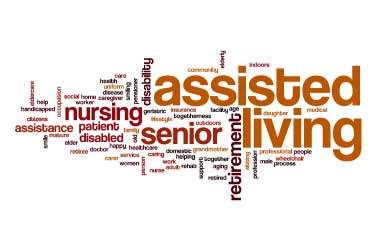Assisted Living Facilities
 In general, there are 3 types of Assisted Living Facilities. “Independent” Senior Living Facilities which offer no assistance with personal care, “Assisted” Living Facilities which provide some aid with personal care based on a level or point scale for an added cost, and “Memory Care” Facilities or ‘Dementia Care” Facilities.
In general, there are 3 types of Assisted Living Facilities. “Independent” Senior Living Facilities which offer no assistance with personal care, “Assisted” Living Facilities which provide some aid with personal care based on a level or point scale for an added cost, and “Memory Care” Facilities or ‘Dementia Care” Facilities.
Most Assisted Living Facilities are large facilities with 50- 150 residents. They are usually very elegant and beautifully appointed. Although the name implies endless assistance, they are most often geared toward independent living for seniors who do not require assistance with daily tasks or personal care. Some might consider them a senior living or Retirement Communities. Physical assistance with personal care (ADL’s & IADL’s) is offered at an additional cost which is added on to the base cost which is typically for a room & meals
Independent Living
 Independent living facilities (Assisted Living Facilities) for seniors usually offer studio or one-bedroom apartments which allow residents a sense of privacy and independence. They provide daily meals in the dining room and weekly cleaning/laundry services. In addition, many facilities provide group activities and offer transportation on a facility bus for residents to go shopping or attend various outings. These services are a benefit for seniors who are relatively independent and are capable of planning, arranging and managing their money and time. It’s important to note that these activities and outings are unaccompanied. For residents who are physically disabled or have mild memory loss, participating in these activities and outings can be very challenging. For example, getting to the bus at the right time and doing their own shopping and then being able to meet the bus again for the return trip home. For independent seniors, who are social, it provides a sense of community and opportunity for social interactions
Independent living facilities (Assisted Living Facilities) for seniors usually offer studio or one-bedroom apartments which allow residents a sense of privacy and independence. They provide daily meals in the dining room and weekly cleaning/laundry services. In addition, many facilities provide group activities and offer transportation on a facility bus for residents to go shopping or attend various outings. These services are a benefit for seniors who are relatively independent and are capable of planning, arranging and managing their money and time. It’s important to note that these activities and outings are unaccompanied. For residents who are physically disabled or have mild memory loss, participating in these activities and outings can be very challenging. For example, getting to the bus at the right time and doing their own shopping and then being able to meet the bus again for the return trip home. For independent seniors, who are social, it provides a sense of community and opportunity for social interactions
Assisted Living
 When a senior starts to need extra home care assistance many people turn to Assisted Living Facilities, thinking that their loved one will be able to age in place in an Assisted Living Facility.
When a senior starts to need extra home care assistance many people turn to Assisted Living Facilities, thinking that their loved one will be able to age in place in an Assisted Living Facility.
In most cases, assistance with personal care and medications are based on a point level or tiered levels of assistance. Each level or item is an additional cost. The cost of these services depends on the amount and number of times each service is needed. Medication management is also based on a tiered system that increases with the number and complexity of the medications.
Generally, most Assisted Living Facilities have 2-3 caregivers, per 50-150 residents. This is a relatively low staff ratio for residents who need assistance with a variety of personal care needs- bathing, dressing, grooming etc. Due to the low caregiver to resident ratio, the care and or service that can be provided is minimal. When care needs increase, residents should expect costs to rise quickly and the maximum service available to plateau, requiring them to move to a Residential Care Home that is smaller and can provide more care.
Likewise, there are only 1-2 medication technicians assigned to manage and administer medications for 50- 150 residents. In most Assisted Living facilities, the duties and responsibilities of caregivers, med techs, meal servers, kitchen staff and receptionist do not cross over, which limits what a staff member can do. Residents may have to wait a long time to get assistance.
Overnight there often is only one caregiver and one medication tech to provide assistance for 50 -150 residents. We know of many seniors who wake up in the middle of the night who are in need of physical assistance or emotional reassurance.
As a senior’s functional status declines it is often difficult for them to be able or motivated to go to the community room and start up conversations and participate in activities. Maybe they have hearing or vision difficulties, limited endurance, difficulty walking or cognitive impairments. Unfortunately, this often leads to isolation. Many people prefer to stay where they are comfortable and do not utilize the group activities and remain isolated in a private room with a closed door. This is something that is often not considered when initially looking for senior care options. It is important to consider the long-term picture as care needs will inevitably increase.
In a smaller, more home like Residential Care Home setting the caregivers and other residents are always around so isolation is minimized, and community interactions are maximized within the course of the usual day’s events. Being around other residents and sharing the day to day activities promotes feelings of belonging, inclusion, listening, companionship and usefulness. Many under value the feeling of inclusion, helping others that arises from sitting with others and being exposed to normal day to day life with many visitors coming and going which can be reduced if you are relatively more isolated in a private room. Having a private room is important, but equally important is the connection to the day to day home life that seniors desire.
Memory Care
 Memory Care Facilities are locked units that are designed to help prevent residents from wandering out of the facility. Some large Assisted Living Facilities have a separate memory care unit on the property which offer separate staff & services.
Memory Care Facilities are locked units that are designed to help prevent residents from wandering out of the facility. Some large Assisted Living Facilities have a separate memory care unit on the property which offer separate staff & services.
Memory care units generally offer a range of rooms choices; private, double or triple shared rooms. Assistance with personal care & medication management is offered on a point or tiered system for added costs. Many people comment that in-patient memory care units have an “Institutional” or “Impersonal “feel when compared to the smaller more personal, family like settings of dementia endorsed Residential Care Homes.
Memory care units and Dementia endorsed Residential care homes are required by the state to provide a minimum staff ratio of 1 caregiver per 6 residents. Most Memory Care Facilities do not go above the minimum state requirement which can be considered a drawback because treatments such as behavioral therapy require a great deal of staff time and often require additional staff & staff training to deliver effective therapies and care. Residents with varying cognitive and physical disabilities require much more time and care than those who are more functional.
Typically, large Assisted livings are corporate owned and are based on more of a financial model rather that a service model of care. Smaller community based settings, such as Residential Care Homes have owners & administrators who are more likely to be personally involved and present in the day to day operations, know their staff, residents and family members on a personal level and likely have more incentive to provide a higher level of personalized care & service than a facility where the owners are shareholders are less personally involved with their staff and residents care.
Licensing & Regulation
To protect seniors from people who may abuse, take advantage and or apply undue influence on seniors, many states have created a regulatory system for Assisted Living Facilities and Assisted Living related services. Nevada is a national leader in regulations for all Assisted Living and Residential Care Homes. Those regulations help give Nevada one of the highest minimum standards for senior living care in the nation.
 Oversite
Oversite
In Nevada, Assisted Living Facilities & Residential Care Homes or Group Homes are licensed under the Bureau of Health Care Quality & Compliance (HCQC) and operate according to Nevada State Laws and Regulations. https://beltca.nv.gov/uploadedFiles/beltcanvgov/content/About/ALL/BELTCA_PositionPaper.pdf.
There are many rules and regulations that facilities are required to follow. Each facility licensed under Residential Facilities for Groups (RFFG) are required to have an annual survey, with the results of the survey, posted on the HCQC web site. Surveys are graded on a letter system of A to D. In addition, facilities receive unannounced visits from the state ombudsman, who observes facilities and interviews the residents, staff & visitors in an effort to ensure minimum standards of care are being met
Rules & Regulations
There are also rules and regulations relating to staff & administrator training, safety and supervision, fire safety, building code to mention a few. Nevada requires oversight of all RFFG’s by a licensed, Residential Facility Administrator (RFA) who receives specialized training and is required to pass the BELTCA (Board of Examiners for Long Term Care Administrators) test or National Association of Long Term Care Administrators Boards (NAB) test. RFA’s are also required to take the state approved Medication Management training and pass the state approved Medication Management test annually.
 A Residential Facility Administrator (RFA) who works for large, Assisted Living Facilities (ALF) has the responsibility to provide protective supervision to 50-150 residents depending on the size of the facility. The low staff to administrator ratio could be a drawback depending on the amount of care & service needed by the resident. With such a large number of residents to supervise it’s possible the quality and amount of personal attention each resident will receive could be reduced. We imagine it is a difficult task for an BELTCA licensed administrator (RFA) of an Assisted Living facility, overseeing 50-150 residents, to personally know and coordinate all aspects of service and care for all 50- 150residnets. Of course, administrators may delegate management and problem solving to other, less trained /skilled staff, which could reduce continuity of care.
A Residential Facility Administrator (RFA) who works for large, Assisted Living Facilities (ALF) has the responsibility to provide protective supervision to 50-150 residents depending on the size of the facility. The low staff to administrator ratio could be a drawback depending on the amount of care & service needed by the resident. With such a large number of residents to supervise it’s possible the quality and amount of personal attention each resident will receive could be reduced. We imagine it is a difficult task for an BELTCA licensed administrator (RFA) of an Assisted Living facility, overseeing 50-150 residents, to personally know and coordinate all aspects of service and care for all 50- 150residnets. Of course, administrators may delegate management and problem solving to other, less trained /skilled staff, which could reduce continuity of care.
On the other hand, smaller Residential Care Homes, typically have a higher administrator to resident ratio and are available to offer more personalized care due to their smaller size, but both are regulated under the same regulations.
The state also has various types of endorsements with additional regulations; dementia, chronic illness, mental illness. The dementia endorsement is required for all RFFG’s (Memory Care Units & Residential Care Homes) who care for those with Alzheimer’s or Dementia care. The Alzheimer’s or Dementia endorsement is the only endorsement that requires a staff minimum of 1 caregiver per 6 residents, added training for the caregivers, and an awake caregiver at night. The Alzheimer’s or Dementia care endorsement are required for Assisted Living Facilities with a Memory Care Unit and Residential Care Homes that care for those with Dementia.
It is important for consumers to be aware of the type of facility they reside in and the types of regulation and safe guards in place to help protect seniors. For example, many independent senior living facilities or communities that provide housekeeping & laundry services may not offer the same protections for those facilities as ones licensed under RFFG’s Chapter 449. Nevada is truly a leader in their protection of senior’s rights and enforcement of a high minimum standard of care throughout the licensed care options
